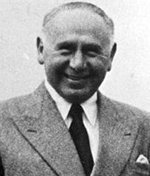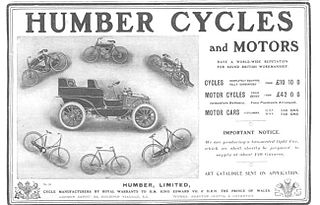Related Research Articles

A flat-four engine, also known as a horizontally opposed-four engine or boxer engine, is a four-cylinder piston engine with two banks of cylinders lying on opposite sides of a common crankshaft. The most common type of flat-four engine is the boxer-four engine, each pair of opposed pistons moves inwards and outwards at the same time.
Coventry Victor was a British motorcycle and car manufacturer. Originally Morton & Weaver, a proprietary engine manufacturer in Hillfields, Coventry, founded in 1904, the company changed its name to Coventry Victor Motors in 1911. The company closed in 1971.
Armstrong Siddeley was a British engineering group that operated during the first half of the 20th century. It was formed in 1919 and is best known for the production of luxury vehicles and aircraft engines.
Sir W G Armstrong Whitworth & Co Ltd was a major British manufacturing company of the early years of the 20th century. With headquarters in Elswick, Newcastle upon Tyne, Armstrong Whitworth built armaments, ships, locomotives, automobiles and aircraft.

L'Aster, Aster, Ateliers de Construction Mecanique l'Aster, was a French manufacturer of automobiles and the leading supplier of engines to other manufacturers from the late 1890s until circa 1910/12. Although primarily known as an engine mass manufacturer the company also produced chassis for coach-works and a complete range of components.

Tiny was a British cyclecar manufactured by Nanson, Barker & Co at Esholt, Yorkshire between 1912 and 1915.

The Siddeley-Deasy Motor Car Company Limited was a British automobile, aero engine and aircraft company based in Coventry in the early 20th century. It was central to the formation, by merger and buy-out, of the later Armstrong Siddeley Motor and Armstrong Whitworth Aircraft companies.
The Alvechurch, ALC, was a British cyclecar manufactured by the Alvechurch Light Car Company in Alvechurch, near Birmingham, England, in 1911. The company was owned by Dunkleys, a pram maker, who also made cars under their own name.

The Woodrow was a British cyclecar manufactured in Stockport from 1913 to 1915.

The Armstrong Siddeley Leopard was a British 14-cylinder twin-row air-cooled radial aero engine developed in 1927 by Armstrong Siddeley. It was the most powerful radial engine in the world when introduced.

The Armstrong Siddeley Jaguar is an aircraft engine developed by Armstrong Siddeley. The Jaguar was a petrol-fuelled air-cooled 14-cylinder two-row radial engine design. The Jaguar III was first used in 1923, followed in 1925 by the Jaguar IV and in 1927 by the Jaguar VI. In 1925 the Jaguar became the first production aero engine incorporating a geared supercharger.
Major Walter Gordon Wilson was an Irish mechanical engineer, inventor and member of the British Royal Naval Air Service. He was credited by the 1919 Royal Commission on Awards to Inventors as the co-inventor of the tank, along with Sir William Tritton.

Douglas was a British motorcycle manufacturer from 1907 to 1957 based in Kingswood, Bristol, owned by the Douglas family, and especially known for its horizontally opposed twin cylinder engined bikes and as manufacturers of speedway machines. The company also built a range of cars between 1913 and 1922.
Grahame-White was an early British aircraft manufacturer, flying school and later manufacturer of cyclecars.
The Buckingham was an English automobile manufactured by the Buckingham Engineering Company in Coventry from 1914 until 1923. The company had made cars under the Chota name from 1912.
Baughan was a British cyclecar and motorcycle manufacturer in business from 1920 until 1936. Founded in 1920 in Harrow, Middlesex, from 1921 the company moved to Stroud, Gloucestershire. After motorcycle production finished the company continued in general engineering and plastics.

The Blériot-Whippet was a British 4 wheeled cyclecar made from 1920 to 1927 by the Air Navigation and Engineering Company based in Addlestone, Surrey.

Nicholas Peter Sorrel Straussler was an engineer mainly remembered for devising the flotation system used by Allied amphibious DD tanks during World War II. He also designed several armoured cars and tanks, including the 39M Csaba armoured car and the Straussler V-4 amphibious light tank. Born in Hungary, he developed a reputation as an innovative automotive engineer before becoming a British citizen during the interwar period. His work was mainly to do with amphibious, off-road and military vehicles.

The Warne was a British 4-wheeled cyclecar made from 1912 to 1915 by Pearsall Warne Ltd at the Icknield Works in Letchworth, Hertfordshire.

Humber Limited was a pioneering British motorcycle manufacturer. Humber produced the first practical motorcycle made in Britain by fitting one of their Humber bicycles with an E. J. Pennington two-horsepower motor in 1896.
References
- 1 2 3 4 Culshaw; Horrobin (1974). Complete Catalogue of British Cars. London: Macmillan. ISBN 0-333-16689-2.
- ↑ Georgano, G.N. (2000). Beaulieu Encyclopedia of the Automobile. London: HMSO. ISBN 1-57958-293-1.